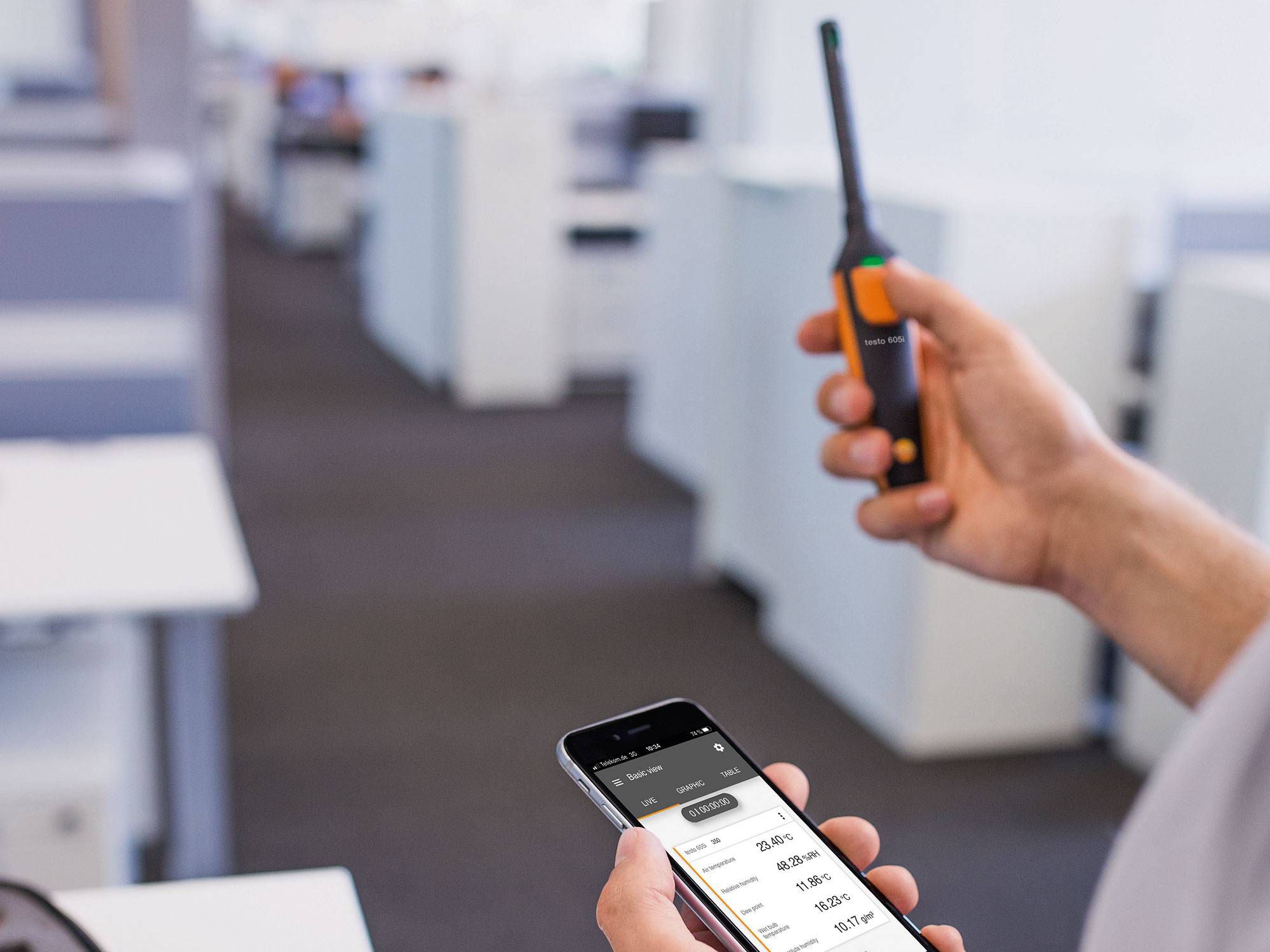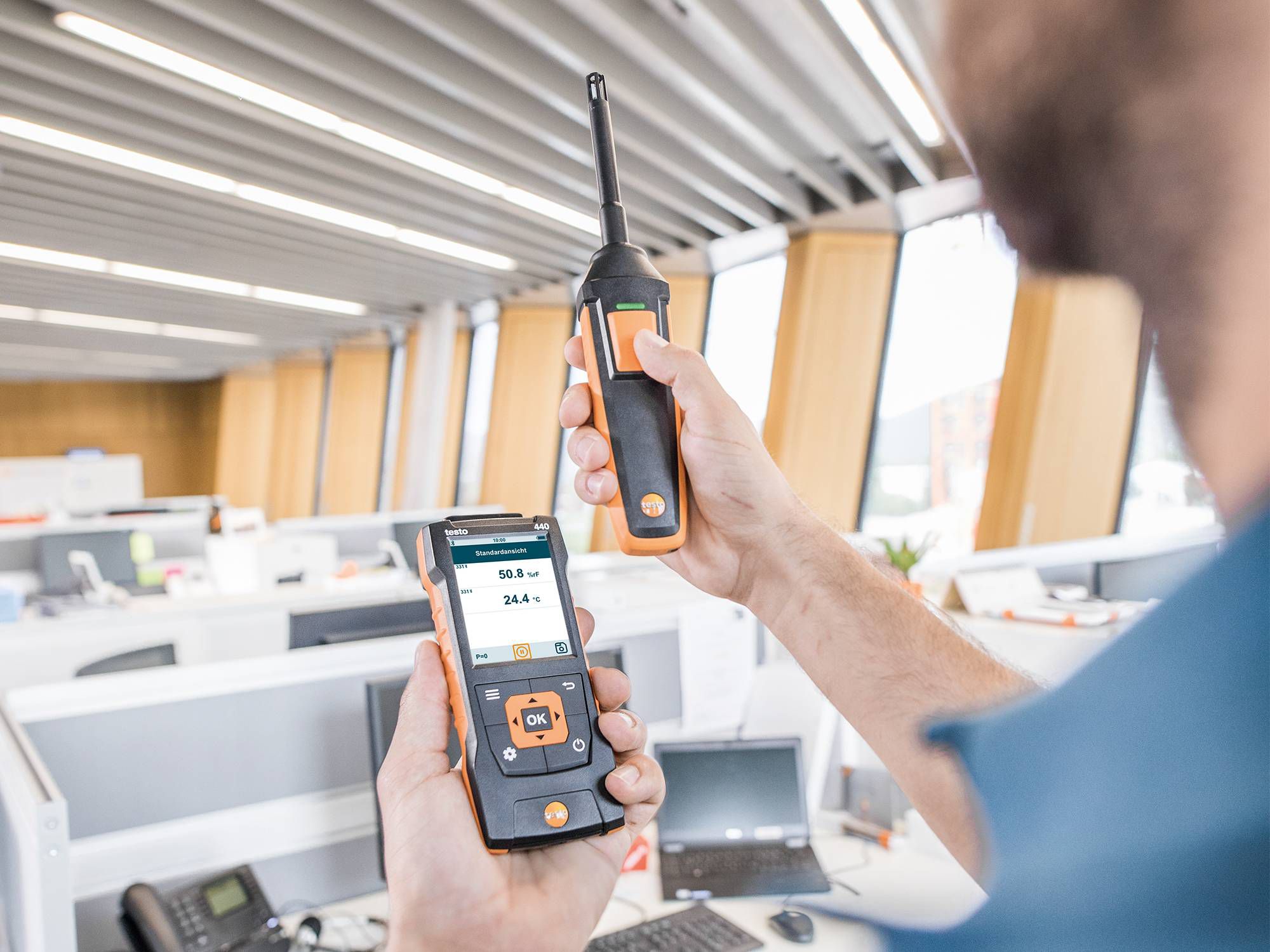Humidity meters: Reliable determination of key measurement parameters
Humidity is one of the most important measurement parameters, and is usually determined in conjunction with temperature and pressure. Humidity and temperature are two key parameters when it comes to indoor climate. In addition to these values, the hygrometer also reads out other parameters and can determine the dew point or water content of the air, for example. So-called IAQ data loggers even allow automatic storage and subsequent evaluation of the values on the PC. Users benefit from the following options when it comes to measuring humidity with a hygrometer:
- Stable humidity sensors in the measuring instruments
- Built-in or externally mounted humidity probe
- Can also be used in complex environments
- Robust construction
- Large display with illumination
Everything is possible: measure air humidity with Testo
Thermohygrometer
Also calculates dewpoint and wet bulb temperature.
Infrared thermometer with humidity measurement
With 4-point laser and 50:1 lens for remote measurement of air humidity.
Humidity meters with-smartphone-operation
Fast, digital, highly efficient and with an App.
Meters with connectable probes
Measure air humidity and other VAC parameters with just one instrument.
Humidity probes
Wide variety of external probes – for every application involving humidity measurement.
More efficiency always implies: the right humidity meter
Humidity meters: Reliable determination of key measurement parameters
The humidity meter is an easy-to-use measuring instrument that works with a high degree of precision. It is always important to maintain the correct distance from cooler surfaces, because in the direct vicinity of cold surfaces that emit this cold, the humidity is higher than in warm air. A value measured here would simply be wrong and not a meaningful indicator for the whole room.
It is also important to centre the measurement probe in the room and to maintain a height of approx. 60 cm. The humidity meter should be moved during the measuring process, a gentle swing back and forth is sufficient. This keeps the acclimatization time low. This is the time it takes for the humidity meter to acclimatize. If you deem it of great importance to achieve the most accurate results, then make sure you give the instrument a long enough time to adjust to a different temperature than the previous one.
If hygrometers are used to measure the humidity, it is important to make certain that your own breath does not affect the sensor. Breathing air is humid and will falsify the measurement result.
The following instruments can be used in combination with the humidity meter or can collect various data simultaneously with the hygrometer:
- Thermohygrometer (humidity meter and thermometer) for calculating the dew point and wet bulb temperature
- Infrared thermometer with humidity meter
- Smart Probes (humidity and temperature probes that can be used and read out via a smartphone)
Measuring humidity: What does a humidity meter measure?
As part of its measurements, a humidity meter determines the moisture content of the air. Just like a thermometer measures temperature, a humidity measuring instrument is concerned with the water vapour content in the air and measures this. It is important to note that, contrary to frequent assumptions, more water vapour is present in warm air than in cooler air. Architects and builders know this: a building shell construction therefore rests during the winter months, the walls would not dry in summer with high temperatures and high humidity in the air. Cold, on the other hand, removes moisture. Measurements undertaken by a humidity meter:
- Relative humidity: indicated in percent, the value is calculated by determining the existing humidity in the room and the maximum humidity
- Absolute humidity: indicated in g/m³, calculated from the amount of water vapour in a closed room with a size of 1 m³
- Dew point: temperature level at which condensation can occur
Moisture in the air: Humidity meters calculate this value
No doubt you are familiar with the humidity meters for use at home. Most people use these measuring instruments in their little weather station at home. There, multiple values are measured and shown on the display. But humidity meters are also used in industry. For example, they are used in industrial humidity measurement, in the calculation of cold chain values and in clean rooms. The measuring tasks vary, and there is an appropriate Testo measuring instrument for all of them. Moisture meters are also available for critical situations, where adaptation to the intended purpose is more important than technical superiority.
Humidity meters: Different measuring instruments for different requirements
Heating and ventilation systems are adjusted in order to provide a comfortable indoor climate. Relative humidity plays a role here, because, in conjunction with the temperature values, this determines the indoor air quality. It should be between 30 and 65 percent, to ensure that everyone feels comfortable. Other tasks for humidity meters are, for example:
- Detection of mould: Incorrect ventilation and structural defects cause mould. A humidity meter can calculate the dew point and locate vulnerable points in the building.
- Long-term monitoring: Collection of the IAQ data of a room over an extended period of time
- Measurement of material moisture: The material moisture measuring instrument monitors conditions for the storage of various substances, whereby the moisture content of the stored substances themselves can also be checked.
Measuring humidity and identifying influencing factors
The humidity meter calculates the humidity in a room. However, it is important to not only know the value, but also to know what this is the result of. The humidity increases with the number of people in the room. Ventilation behaviour also plays a role: If humid air can escape regularly, the indoor climate stays more pleasant and drier. Building materials absorb or release different amounts of moisture, so this point should also be taken into account when monitoring the indoor climate long-term.










